2013 BMW 740LI XDRIVE sunroof
[x] Cancel search: sunroofPage 121 of 243
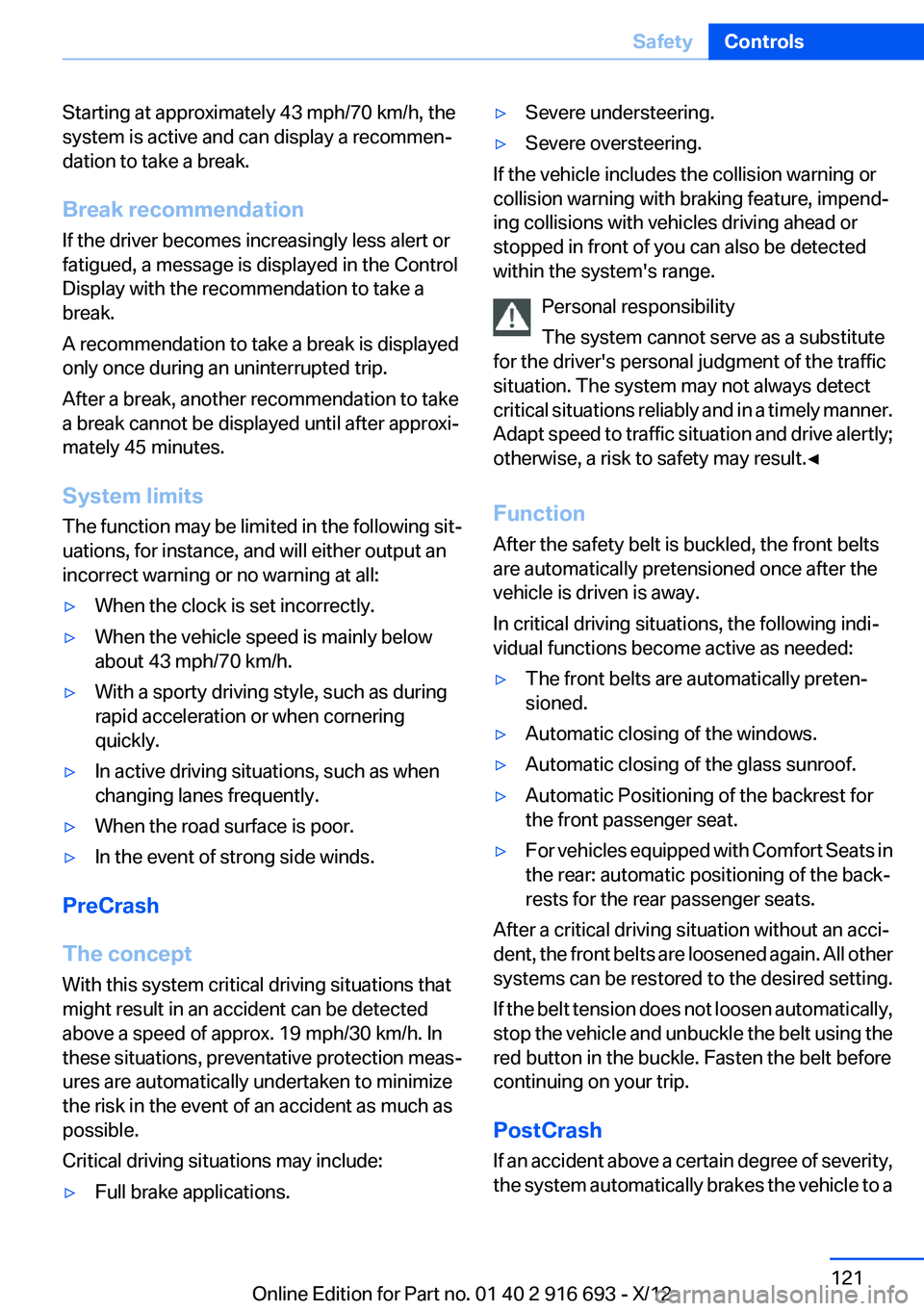
Starting at approximately 43 mph/70 km/h, the
system is active and can display a recommen‐
dation to take a break.
Break recommendation
If the driver becomes increasingly less alert or
fatigued, a message is displayed in the Control
Display with the recommendation to take a
break.
A recommendation to take a break is displayed
only once during an uninterrupted trip.
After a break, another recommendation to take
a break cannot be displayed until after approxi‐
mately 45 minutes.
System limits
The function may be limited in the following sit‐
uations, for instance, and will either output an
incorrect warning or no warning at all:▷When the clock is set incorrectly.▷When the vehicle speed is mainly below
about 43 mph/70 km/h.▷With a sporty driving style, such as during
rapid acceleration or when cornering
quickly.▷In active driving situations, such as when
changing lanes frequently.▷When the road surface is poor.▷In the event of strong side winds.
PreCrash
The concept
With this system critical driving situations that
might result in an accident can be detected
above a speed of approx. 19 mph/30 km/h. In
these situations, preventative protection meas‐
ures are automatically undertaken to minimize
the risk in the event of an accident as much as
possible.
Critical driving situations may include:
▷Full brake applications.▷Severe understeering.▷Severe oversteering.
If the vehicle includes the collision warning or
collision warning with braking feature, impend‐
ing collisions with vehicles driving ahead or
stopped in front of you can also be detected
within the system's range.
Personal responsibility
The system cannot serve as a substitute
for the driver's personal judgment of the traffic
situation. The system may not always detect
critical situations reliably and in a timely manner.
Adapt speed to traffic situation and drive alertly;
otherwise, a risk to safety may result.◀
Function
After the safety belt is buckled, the front belts
are automatically pretensioned once after the
vehicle is driven is away.
In critical driving situations, the following indi‐
vidual functions become active as needed:
▷The front belts are automatically preten‐
sioned.▷Automatic closing of the windows.▷Automatic closing of the glass sunroof.▷Automatic Positioning of the backrest for
the front passenger seat.▷For vehicles equipped with Comfort Seats in
the rear: automatic positioning of the back‐
rests for the rear passenger seats.
After a critical driving situation without an acci‐
dent, the front belts are loosened again. All other
systems can be restored to the desired setting.
If the belt tension does not loosen automatically,
stop the vehicle and unbuckle the belt using the
red button in the buckle. Fasten the belt before
continuing on your trip.
PostCrash
If an accident above a certain degree of severity,
the system automatically brakes the vehicle to a
Seite 121SafetyControls121
Online Edition for Part no. 01 40 2 916 693 - X/12
Page 174 of 243
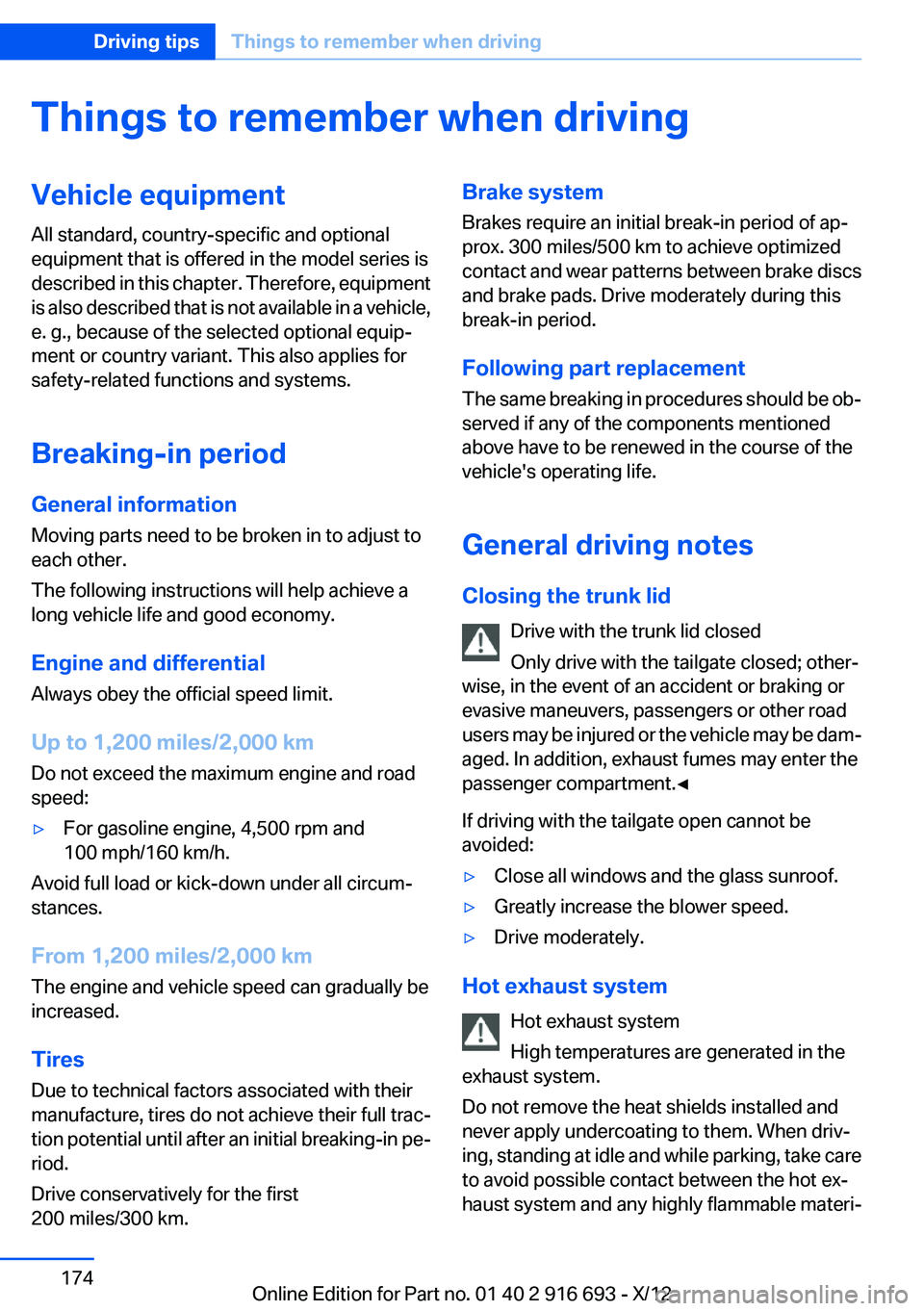
Things to remember when drivingVehicle equipment
All standard, country-specific and optional
equipment that is offered in the model series is
described in this chapter. Therefore, equipment
is also described that is not available in a vehicle,
e. g., because of the selected optional equip‐
ment or country variant. This also applies for
safety-related functions and systems.
Breaking-in period
General information
Moving parts need to be broken in to adjust to
each other.
The following instructions will help achieve a
long vehicle life and good economy.
Engine and differential
Always obey the official speed limit.
Up to 1,200 miles/2,000 km
Do not exceed the maximum engine and road
speed:▷For gasoline engine, 4,500 rpm and
100 mph/160 km/h.
Avoid full load or kick-down under all circum‐
stances.
From 1,200 miles/2,000 km
The engine and vehicle speed can gradually be
increased.
Tires
Due to technical factors associated with their
manufacture, tires do not achieve their full trac‐
tion potential until after an initial breaking-in pe‐
riod.
Drive conservatively for the first
200 miles/300 km.
Brake system
Brakes require an initial break-in period of ap‐
prox. 300 miles/500 km to achieve optimized
contact and wear patterns between brake discs
and brake pads. Drive moderately during this
break-in period.
Following part replacement
The same breaking in procedures should be ob‐
served if any of the components mentioned
above have to be renewed in the course of the
vehicle's operating life.
General driving notes
Closing the trunk lid Drive with the trunk lid closed
Only drive with the tailgate closed; other‐
wise, in the event of an accident or braking or
evasive maneuvers, passengers or other road
users may be injured or the vehicle may be dam‐
aged. In addition, exhaust fumes may enter the
passenger compartment.◀
If driving with the tailgate open cannot be
avoided:▷Close all windows and the glass sunroof.▷Greatly increase the blower speed.▷Drive moderately.
Hot exhaust system
Hot exhaust system
High temperatures are generated in the
exhaust system.
Do not remove the heat shields installed and
never apply undercoating to them. When driv‐
ing, standing at idle and while parking, take care
to avoid possible contact between the hot ex‐
haust system and any highly flammable materi‐
Seite 174Driving tipsThings to remember when driving174
Online Edition for Part no. 01 40 2 916 693 - X/12
Page 178 of 243
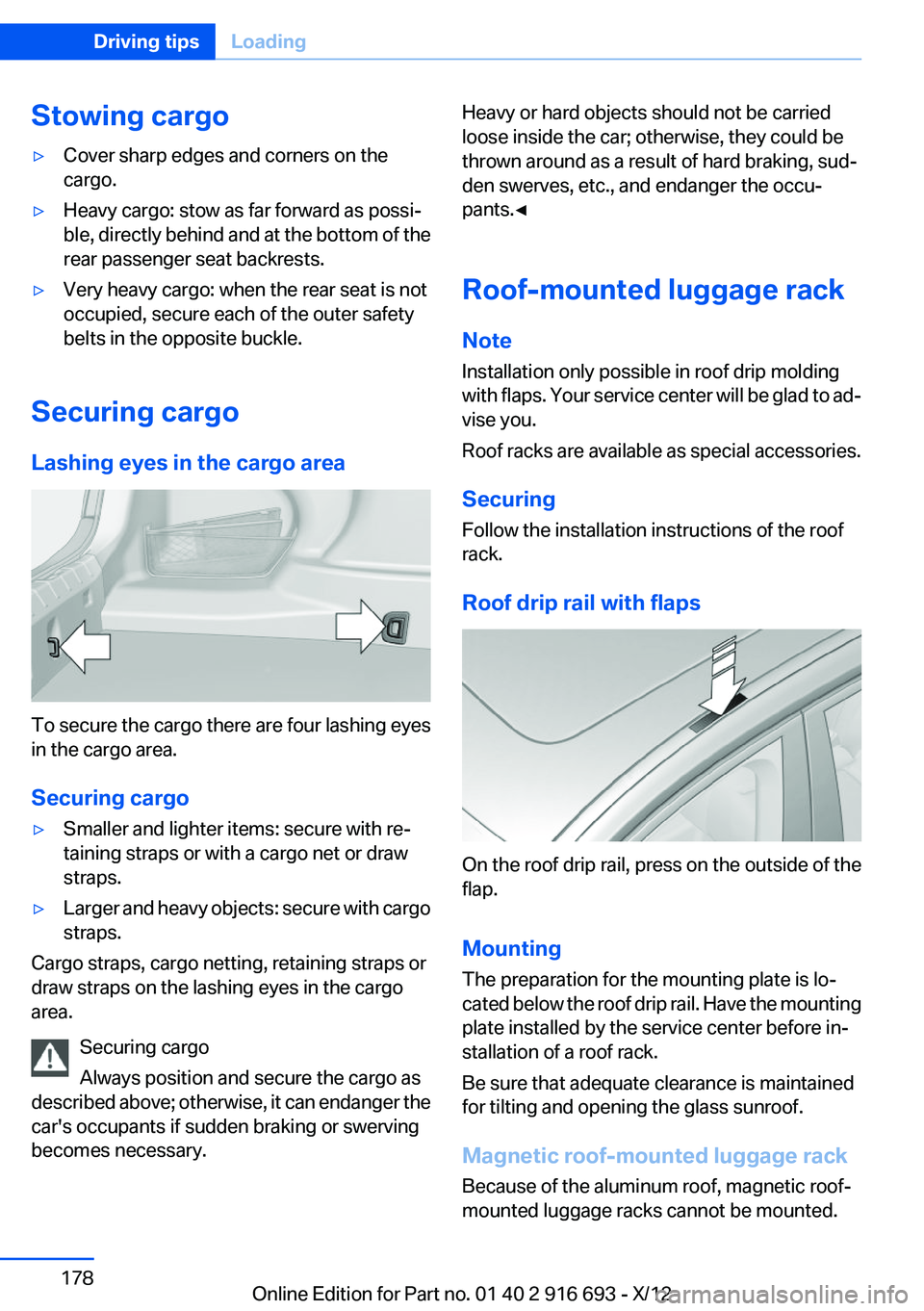
Stowing cargo▷Cover sharp edges and corners on the
cargo.▷Heavy cargo: stow as far forward as possi‐
ble, directly behind and at the bottom of the
rear passenger seat backrests.▷Very heavy cargo: when the rear seat is not
occupied, secure each of the outer safety
belts in the opposite buckle.
Securing cargo
Lashing eyes in the cargo area
To secure the cargo there are four lashing eyes
in the cargo area.
Securing cargo
▷Smaller and lighter items: secure with re‐
taining straps or with a cargo net or draw
straps.▷Larger and heavy objects: secure with cargo
straps.
Cargo straps, cargo netting, retaining straps or
draw straps on the lashing eyes in the cargo
area.
Securing cargo
Always position and secure the cargo as
described above; otherwise, it can endanger the
car's occupants if sudden braking or swerving
becomes necessary.
Heavy or hard objects should not be carried
loose inside the car; otherwise, they could be
thrown around as a result of hard braking, sud‐
den swerves, etc., and endanger the occu‐
pants.◀
Roof-mounted luggage rack
Note
Installation only possible in roof drip molding
with flaps. Your service center will be glad to ad‐
vise you.
Roof racks are available as special accessories.
Securing
Follow the installation instructions of the roof
rack.
Roof drip rail with flaps
On the roof drip rail, press on the outside of the
flap.
Mounting
The preparation for the mounting plate is lo‐
cated below the roof drip rail. Have the mounting
plate installed by the service center before in‐
stallation of a roof rack.
Be sure that adequate clearance is maintained
for tilting and opening the glass sunroof.
Magnetic roof-mounted luggage rack
Because of the aluminum roof, magnetic roof-
mounted luggage racks cannot be mounted.
Seite 178Driving tipsLoading178
Online Edition for Part no. 01 40 2 916 693 - X/12
Page 180 of 243
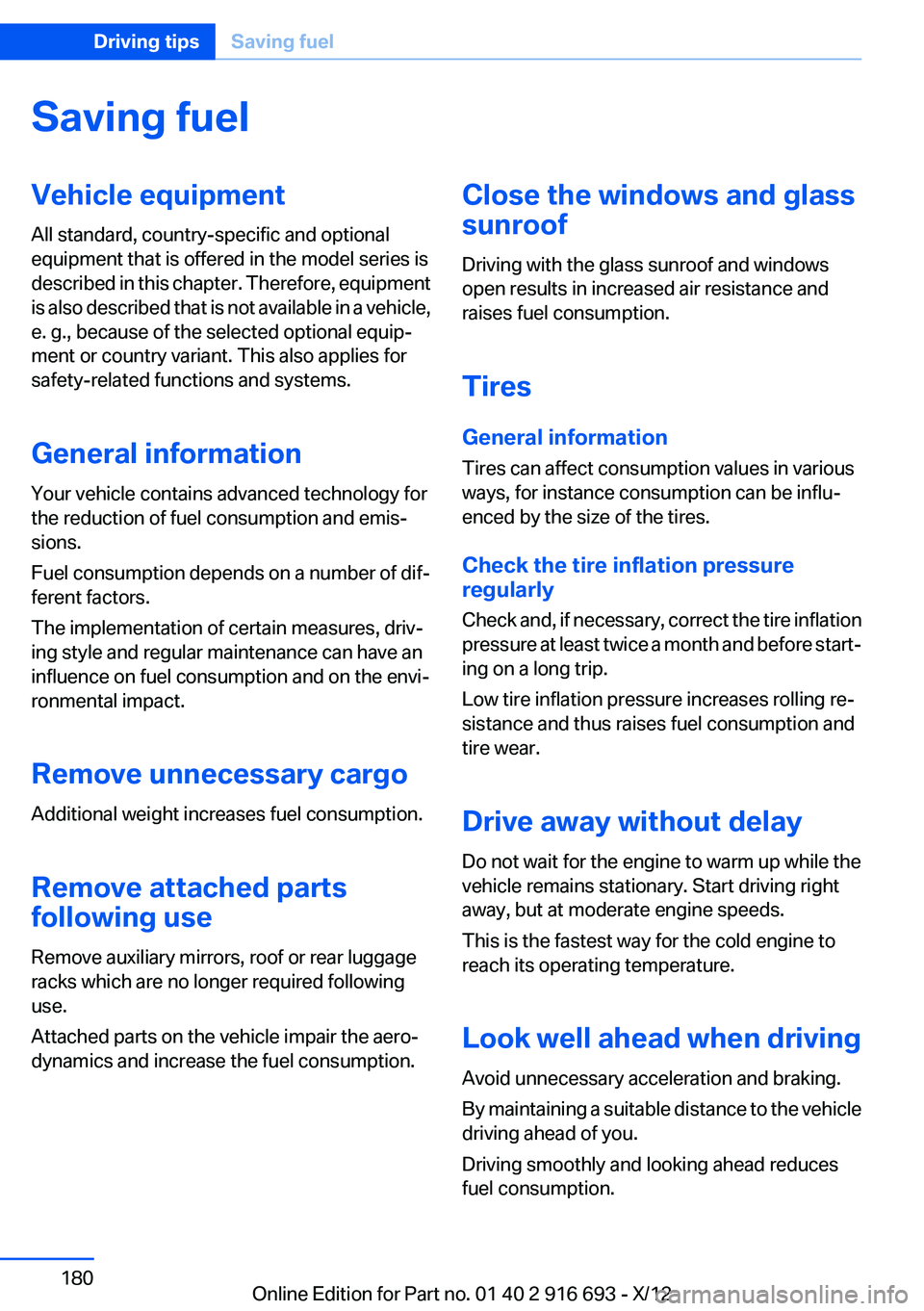
Saving fuelVehicle equipment
All standard, country-specific and optional
equipment that is offered in the model series is
described in this chapter. Therefore, equipment
is also described that is not available in a vehicle,
e. g., because of the selected optional equip‐
ment or country variant. This also applies for
safety-related functions and systems.
General information
Your vehicle contains advanced technology for
the reduction of fuel consumption and emis‐
sions.
Fuel consumption depends on a number of dif‐
ferent factors.
The implementation of certain measures, driv‐
ing style and regular maintenance can have an
influence on fuel consumption and on the envi‐
ronmental impact.
Remove unnecessary cargo
Additional weight increases fuel consumption.
Remove attached parts
following use
Remove auxiliary mirrors, roof or rear luggage
racks which are no longer required following
use.
Attached parts on the vehicle impair the aero‐
dynamics and increase the fuel consumption.Close the windows and glass
sunroof
Driving with the glass sunroof and windows
open results in increased air resistance and
raises fuel consumption.
Tires
General information
Tires can affect consumption values in various
ways, for instance consumption can be influ‐
enced by the size of the tires.
Check the tire inflation pressure
regularly
Check and, if necessary, correct the tire inflation
pressure at least twice a month and before start‐
ing on a long trip.
Low tire inflation pressure increases rolling re‐
sistance and thus raises fuel consumption and
tire wear.
Drive away without delay
Do not wait for the engine to warm up while the
vehicle remains stationary. Start driving right
away, but at moderate engine speeds.
This is the fastest way for the cold engine to
reach its operating temperature.
Look well ahead when driving
Avoid unnecessary acceleration and braking.
By maintaining a suitable distance to the vehicle
driving ahead of you.
Driving smoothly and looking ahead reduces
fuel consumption.Seite 180Driving tipsSaving fuel180
Online Edition for Part no. 01 40 2 916 693 - X/12
Page 235 of 243
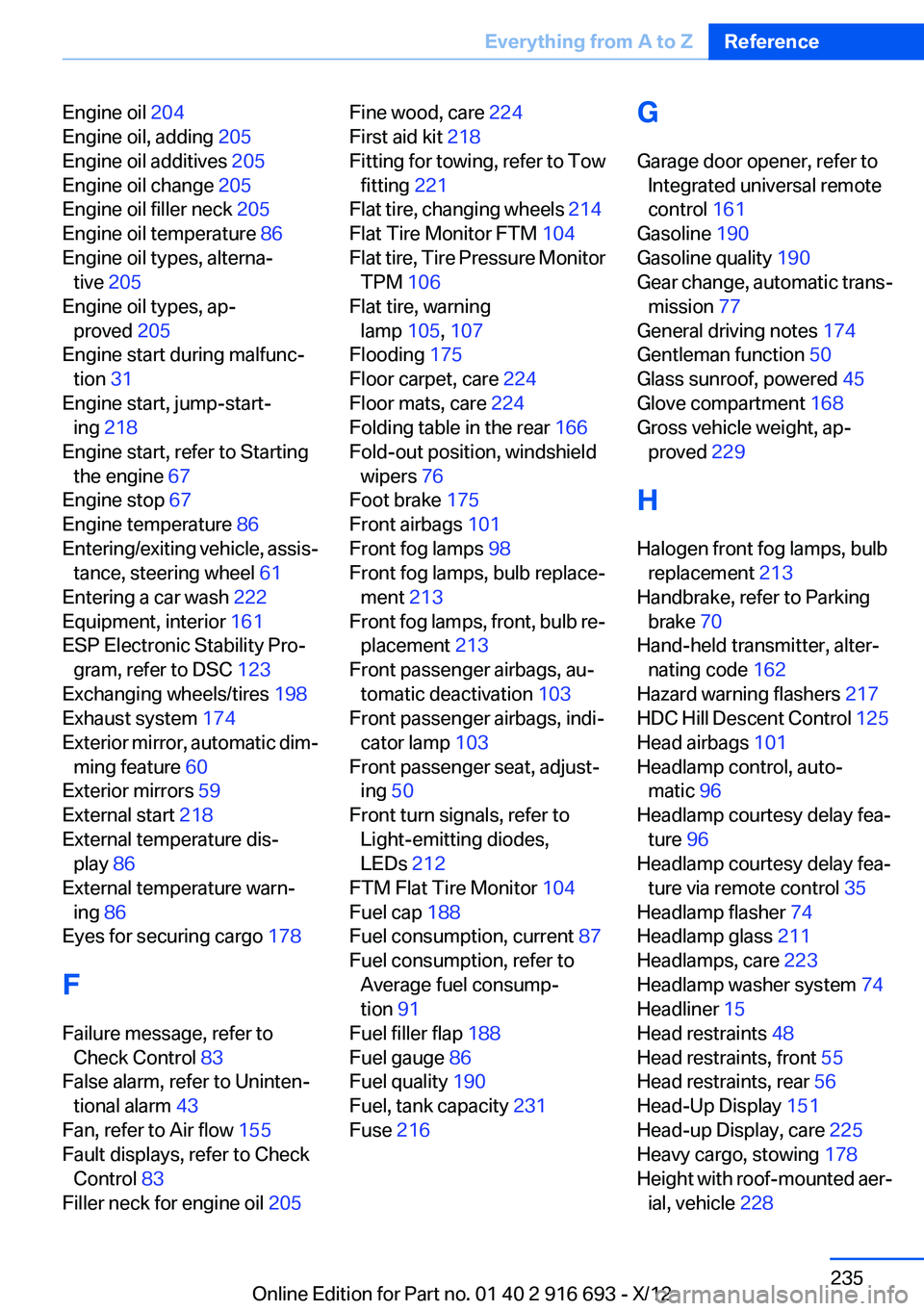
Engine oil 204
Engine oil, adding 205
Engine oil additives 205
Engine oil change 205
Engine oil filler neck 205
Engine oil temperature 86
Engine oil types, alterna‐ tive 205
Engine oil types, ap‐ proved 205
Engine start during malfunc‐ tion 31
Engine start, jump-start‐ ing 218
Engine start, refer to Starting the engine 67
Engine stop 67
Engine temperature 86
Entering/exiting vehicle, assis‐ tance, steering wheel 61
Entering a car wash 222
Equipment, interior 161
ESP Electronic Stability Pro‐ gram, refer to DSC 123
Exchanging wheels/tires 198
Exhaust system 174
Exterior mirror, automatic dim‐ ming feature 60
Exterior mirrors 59
External start 218
External temperature dis‐ play 86
External temperature warn‐ ing 86
Eyes for securing cargo 178
F
Failure message, refer to Check Control 83
False alarm, refer to Uninten‐ tional alarm 43
Fan, refer to Air flow 155
Fault displays, refer to Check Control 83
Filler neck for engine oil 205 Fine wood, care 224
First aid kit 218
Fitting for towing, refer to Tow fitting 221
Flat tire, changing wheels 214
Flat Tire Monitor FTM 104
Flat tire, Tire Pressure Monitor TPM 106
Flat tire, warning lamp 105, 107
Flooding 175
Floor carpet, care 224
Floor mats, care 224
Folding table in the rear 166
Fold-out position, windshield wipers 76
Foot brake 175
Front airbags 101
Front fog lamps 98
Front fog lamps, bulb replace‐ ment 213
Front fog lamps, front, bulb re‐ placement 213
Front passenger airbags, au‐ tomatic deactivation 103
Front passenger airbags, indi‐ cator lamp 103
Front passenger seat, adjust‐ ing 50
Front turn signals, refer to Light-emitting diodes,
LEDs 212
FTM Flat Tire Monitor 104
Fuel cap 188
Fuel consumption, current 87
Fuel consumption, refer to Average fuel consump‐
tion 91
Fuel filler flap 188
Fuel gauge 86
Fuel quality 190
Fuel, tank capacity 231
Fuse 216 G
Garage door opener, refer to Integrated universal remote
control 161
Gasoline 190
Gasoline quality 190
Gear change, automatic trans‐ mission 77
General driving notes 174
Gentleman function 50
Glass sunroof, powered 45
Glove compartment 168
Gross vehicle weight, ap‐ proved 229
H
Halogen front fog lamps, bulb replacement 213
Handbrake, refer to Parking brake 70
Hand-held transmitter, alter‐ nating code 162
Hazard warning flashers 217
HDC Hill Descent Control 125
Head airbags 101
Headlamp control, auto‐ matic 96
Headlamp courtesy delay fea‐ ture 96
Headlamp courtesy delay fea‐ ture via remote control 35
Headlamp flasher 74
Headlamp glass 211
Headlamps, care 223
Headlamp washer system 74
Headliner 15
Head restraints 48
Head restraints, front 55
Head restraints, rear 56
Head-Up Display 151
Head-up Display, care 225
Heavy cargo, stowing 178
Height with roof-mounted aer‐ ial, vehicle 228 Seite 235Everything from A to ZReference235
Online Edition for Part no. 01 40 2 916 693 - X/12
Page 238 of 243
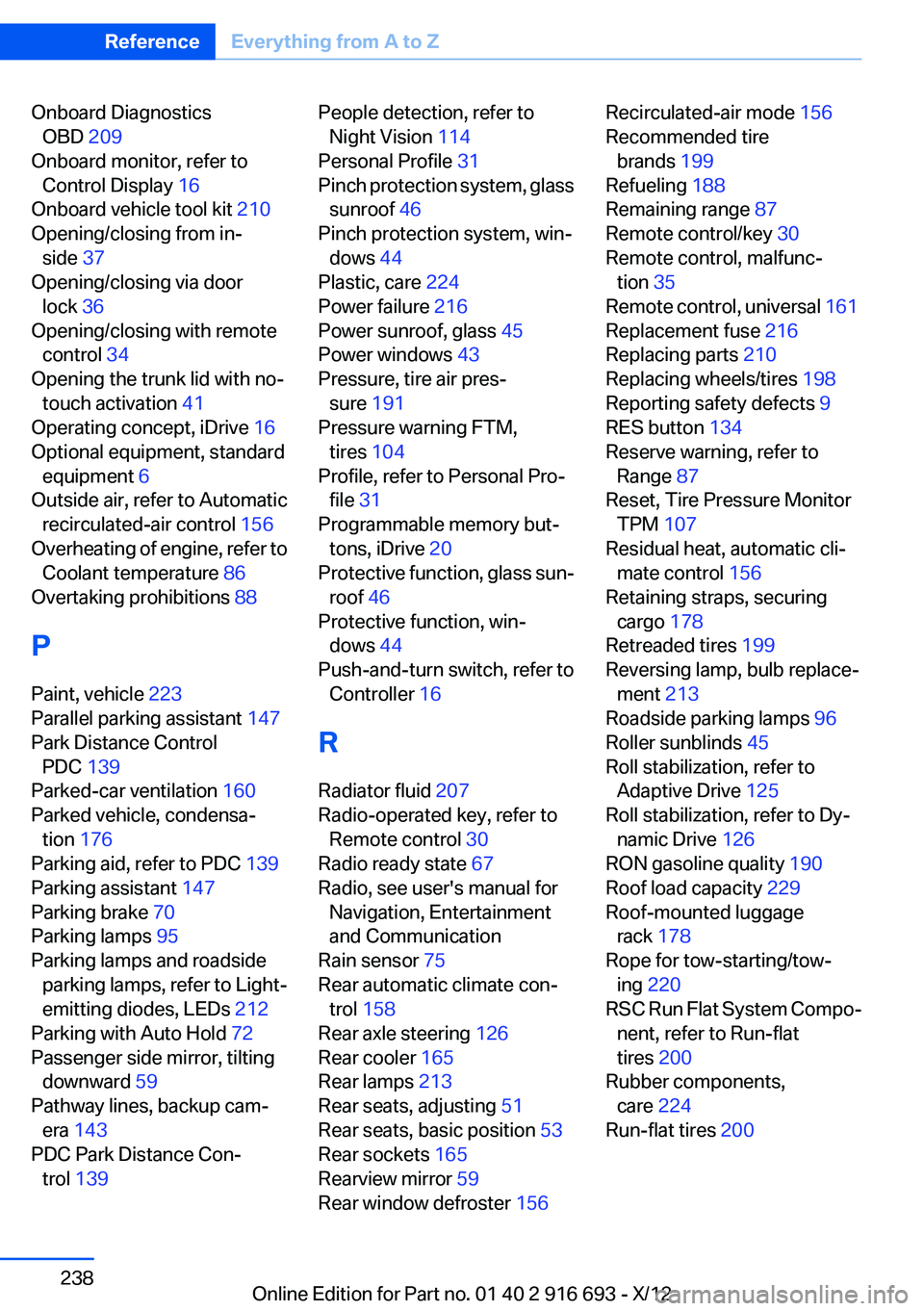
Onboard DiagnosticsOBD 209
Onboard monitor, refer to Control Display 16
Onboard vehicle tool kit 210
Opening/closing from in‐ side 37
Opening/closing via door lock 36
Opening/closing with remote control 34
Opening the trunk lid with no- touch activation 41
Operating concept, iDrive 16
Optional equipment, standard equipment 6
Outside air, refer to Automatic recirculated-air control 156
Overheating of engine, refer to Coolant temperature 86
Overtaking prohibitions 88
P
Paint, vehicle 223
Parallel parking assistant 147
Park Distance Control PDC 139
Parked-car ventilation 160
Parked vehicle, condensa‐ tion 176
Parking aid, refer to PDC 139
Parking assistant 147
Parking brake 70
Parking lamps 95
Parking lamps and roadside parking lamps, refer to Light-
emitting diodes, LEDs 212
Parking with Auto Hold 72
Passenger side mirror, tilting downward 59
Pathway lines, backup cam‐ era 143
PDC Park Distance Con‐ trol 139 People detection, refer to
Night Vision 114
Personal Profile 31
Pinch protection system, glass sunroof 46
Pinch protection system, win‐ dows 44
Plastic, care 224
Power failure 216
Power sunroof, glass 45
Power windows 43
Pressure, tire air pres‐ sure 191
Pressure warning FTM, tires 104
Profile, refer to Personal Pro‐ file 31
Programmable memory but‐ tons, iDrive 20
Protective function, glass sun‐ roof 46
Protective function, win‐ dows 44
Push-and-turn switch, refer to Controller 16
R
Radiator fluid 207
Radio-operated key, refer to Remote control 30
Radio ready state 67
Radio, see user's manual for Navigation, Entertainment
and Communication
Rain sensor 75
Rear automatic climate con‐ trol 158
Rear axle steering 126
Rear cooler 165
Rear lamps 213
Rear seats, adjusting 51
Rear seats, basic position 53
Rear sockets 165
Rearview mirror 59
Rear window defroster 156 Recirculated-air mode 156
Recommended tire brands 199
Refueling 188
Remaining range 87
Remote control/key 30
Remote control, malfunc‐ tion 35
Remote control, universal 161
Replacement fuse 216
Replacing parts 210
Replacing wheels/tires 198
Reporting safety defects 9
RES button 134
Reserve warning, refer to Range 87
Reset, Tire Pressure Monitor TPM 107
Residual heat, automatic cli‐ mate control 156
Retaining straps, securing cargo 178
Retreaded tires 199
Reversing lamp, bulb replace‐ ment 213
Roadside parking lamps 96
Roller sunblinds 45
Roll stabilization, refer to Adaptive Drive 125
Roll stabilization, refer to Dy‐ namic Drive 126
RON gasoline quality 190
Roof load capacity 229
Roof-mounted luggage rack 178
Rope for tow-starting/tow‐ ing 220
RSC Run Flat System Compo‐ nent, refer to Run-flat
tires 200
Rubber components, care 224
Run-flat tires 200 Seite 238ReferenceEverything from A to Z238
Online Edition for Part no. 01 40 2 916 693 - X/12